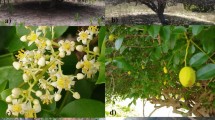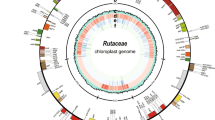Abstract
Vigna unguiculata is the major grain legume in Africa and is also important in South-East Asia as a vegetable. The wild relatives, present only in Africa, are currently made of ten subspecies. However, while the different groups are well identified, the relationships between them are not firmly established. The present study of chloroplast diversity through restriction fragment length polymorphism confirms the different groups, as well as the split between savannah subspecies and forest subspecies. It justifies treating subsp. stenophylla as a subspecies independent from subsp. protracta and invalidates the subsp. stenophylla sensu lato concept. It suggests that the species V. unguiculata originated in southern Africa and that the annual subsp. unguiculata var. spontanea originated in eastern Africa. More importantly, it proves that three subspecies are of hybrid origin, between the annual var. spontanea and various perennial subspecies from southern Africa with left-twisted keel. Owing to its annual and inbred properties, var. spontanea spread across all African low- to medium-altitude savannahs, displacing the left-twisted keel savannah perennials from their warmer and drier areas.





Similar content being viewed by others
References
Aliyu B (2005) Crossability of Vigna rhomboidea Burtt. Davy with cowpea (V. unguiculata (L.) walp.). Genet Resour Crop Evol 52:447–453
Ariani A, Berny Mier y Teran J, Gepts P (2018) Spatial and temporal scales of range expansion in wild Phaseolus vulgaris. Mol Biol Evol 35:119–131
Azani N, Bruneau A, Wojciechowski MF, Zarre S (2019) Miocene climate change as a driving force for multiple origins of annual species in Astragalus (Fabaceae, Papilionoideae). Mol Phylogenet Evol 137:210–221
Bett B, Gollasch S, Moore A, James W, Armstrong J, Walsh T, Harding R, Higgins TJV (2017) Transgenic cowpeas (Vigna unguiculata L. Walp) expressing Bacillus thuringiensis Vip3Ba protein are protected against the Maruca pod borer (Maruca vitrata). Plant Cell Tissue Organ Cult 131:335–345
Boukar O, Fatokun CA, Huynh BL, Roberts PA, Close TJ (2016) Genomic Tools in Cowpea Breeding Programs: Status and Perspectives. Front Plant Sci 7:757
Burgess ND, Clarke GP, Rodgers WA (1998) Coastal forests of eastern Africa: status, endemism patterns and their potential causes. Biol J Linnean Soc 64:337–367
Byrne M, MacDonald B, Coates D (2002) Phylogeographical patterns in chloroplast DNA variation within the Acacia acuminata (Leguminosae: Mimosoideae) complex in Western Australia. J Evol Biol 15:576–587
Cannon CH, Manos PS (2003) Phylogeography of the Southeast Asian stone oaks (Lithocarpus). J Biogeogr 30:211–226
Citadin CT, Cruz ARR, Aragao FJL (2013) Development of transgenic imazapyr-tolerant cowpea (Vigna unguiculata). Plant Cell Rep 32:537–543
Comes HP, Abbott RJ (2001) Molecular phylogeography, reticulation, and lineage sorting in Mediterranean Senecio sect. Senecio (Asteraceae). Evolution 55:1943–1962
Couvreur TLP, Chatrou LW, Sosef MSM, Richardson JE (2008) Molecular phylogenetics reveal multiple tertiary vicariance origins of the African rain forest trees. BMC Biol 6:54
Cruz ARR, Aragao FJL (2014) RNAi-based enhanced resistance to Cowpea severe mosaic virus and Cowpea aphid-borne mosaic virus in transgenic cowpea. Plant Pathol 63:831–837
Currat M, Ruedi M, Petit RJ, Excoffier L (2008) The hidden side of invasions: massive introgression by local genes. Evolution 62:1908–1920
Doyle JJ, Doyle JL (1987) A rapid DNA isolation procedure for small quantities of fresh leaf tissue. Phytochem Bull 19:11–15
Durovic S, Schonswetter P, Niketic M, Tomovic G, Frajman B (2017) Disentangling relationships among the members of the Silene saxifraga alliance (Caryophyllaceae): Phylogenetic structure is geographically rather than taxonomically segregated. Taxon 66:343–364
Echikh N (2000) Organisation du pool genique de formes sauvages et cultivees d’une legumineuse alimentaire, Vigna unguiculata (L.) Walp. These de doctorat, Fac Univ Sci Agron, Gembloux
Ehlers JD, Hall AE (1997) Cowpea (Vigna unguiculata L Walp). Field Crop Res 53:187–204
Endler JA (1977) Geographic variation, speciation and clines. Princeton University Press, Princeton
Eyre-Walker A, Gaut BS (1997) Correlated rates of synonymous site evolution across plant genomes. Mol Biol Evol 14:455–460
Fayolle A, Swaine MD, Bastin JF, Bourland N, Comiskey JA, Dauby G, Doucet JL, Gillet JF, Gourlet-Fleury S, Hardy OJ, Kirunda B, Kouame FN, Plumptre AJ (2014) Patterns of tree species composition across tropical African forests. J Biogeogr 41:2320–2331
Feinberg AP, Vogelstein B (1983) A technique for radiolabeling DNA restriction endonuclease fragments to high specific activity. Anal Biochem 132:9–13
Feleke Y, Pasquet RS, Gepts P (2006) Development of PCR-based chloroplast DNA markers to assess gene flow between wild and domesticated cowpea (Vigna unguiculata). Plant Syst Evol 262:75–87
Hardion L, Verlaque R, Vorontsova M, Chen CW, Takamizo T, Combroux I, Vila B (2017) Does infraspecific taxonomy match species evolutionary history? A case study of phylogeography in Arundo formosana (Poaceae). Bot J Linnean Soc 183:236–249
Linder HP, de Klerk HM, Born J, Burgess ND, Fjeldsa J, Rahbek C (2012) The partitioning of Africa: statistically defined biogeographical regions in sub-Saharan Africa. J Biogeogr 39:1189–1205
Lorenzen ED, Masembe C, Arctander P, Siegismund HR (2010) A long standing Pleistocene refugium in southern Africa and a mosaic of refugia in East Africa: insights from mtDNA and the common eland antelope. J Biogeogr 37:571–581
Ma PF, Guo ZH, Li DZ (2012) Rapid sequencing of the bamboo mitochondrial genome using Illumina technology and parallel episodic evolution of organelle genomes in grasses. PloSOne 7:e30297
Maddison WP (1997) Gene trees in species trees. Syst Biol 46:523–536
Mithen R, Kibblewhite H (1993) Taxonomy and ecology of Vigna unguiculata (Leguminosae-Papilionoideae) in South-Central Africa. Kirkia 14:100–113
Munoz-Amatriain M, Mirebrahim H, Xu P, Wanamaker SI, Luo MC, Alhakami H, Alpert M, Atokple I, Batieno BJ, Boukar O, Bozdag S, Cisse N, Drabo I, Ehlers JD, Farmer A, Fatokun C, Gu YQ, Guo YN, Huynh BL, Jackson SA, Kusi F, Lawley CT, Lucas MR, Ma YQ, Timko MP, Wu JJ, You F, Barkley NA, Roberts PA, Lonardi S, Close TJ (2017) Genome resources for climate-resilient cowpea, an essential crop for food security. Plant J 89:1042–1054
Naciri Y, Linder HP (2015) Species delimitation and relationships: the dance of the seven veils. Taxon 64:3–16
Padulosi S (1993) Genetic diversity, taxonomy and ecogeographic survey of the wild relatives of cowpea (Vigna unguiculata (L.) Walpers). PhD Thesis, Université catholique Louvain la Neuve
Padulosi S, Ng NQ (1997) Origin, taxonomy, and morphology of Vigna unguiculata (L.) Walp. In: Singh BB, Mohan Raj DR, Dashiell KE, Jackai LEN (eds) Advances in cowpea research. IITA-JIRCAS, Ibadan, pp 1–12
Palmer JD, Thompson WF (1981) Clone banks of the mung bean, pea and spinach chloroplast genomes. Gene 15:21–26
Pasquet RS (1993a) Classification infraspécifique des formes spontanées de Vigna unguiculata (L.) Walp. à partir de données morphologiques. Bull Jard Bot Nat Belg 62:127–173
Pasquet RS (1993b) Two new subspecies of Vigna unguiculata (L.) Walp. (Leguminosae: Papilionoideae). Kew Bull 48:805–806
Pasquet RS (1997) A new subspecies of Vigna unguiculata (Leguminosae-Papilionoideae). Kew Bull 52:840
Pasquet RS (1999) Genetic relationships among subspecies of Vigna unguiculata (L.) Walp. based on allozyme variation. Theor Appl Genet 98:1104–1119
Pasquet RS (2000) Allozyme diversity of cultivated cowpea Vigna unguiculata (L.) Walp. Theor Appl Genet 101:211–219
Pasquet RS, Baudoin JP (2001) Cowpea. In: Charrier A, Jacquot M, Hamon S, Nicolas D (eds) Tropical plant breeding. Science Publishers, Enfield - CIRAD, Montpellier, pp 177–198
Pasquet RS, Padulosi S (2012) Genus Vigna and cowpea (V. unguiculata [L.] Walp.) taxonomy: current status and prospects. In: Boukar O, Coulibaly O, Fatokun CA, Lopez K, Tamo M (eds) Innovative research along the cowpea value chain. IITA, Ibadan, pp 66–87
Petit RJ, Csaikl UM, Bordacs S, Burg K, Coartd E, Cottrell J, van Dam B, Deans JD, Dumolin-Lapegue S, Fineschi S, Finkeldey R, Gillies A, Glaza I, Goicoechea PG, Jensen JS, Konig AO, Lowe AJ, Madsen SF, Matyas G, Munro RC, Olalde M, Pemonge MH, Popescu F, Slade D, Tabbener H, Taurchini D, de Vries SGM, Ziegenhagen B, Kremer A (2002) Chloroplast DNA variation in European white oaks—phylogeography and patterns of diversity based on data from over 2600 populations. For Ecol Manag 156:5–26
Petit RJ, Bodenes C, Ducousso A, Roussel G, Kremer A (2003) Hybridization as a mechanism of invasion in oaks. New Phytol 161:151–164
Pienaar BJ, Van Wyk AE (1992) The Vigna unguiculata complex (Fabaceae) in southern Africa. S Afr J Bot 58:414–429
Rieseberg LH, Soltis DE (1991) Phylogenetic consequences of cytoplasmic gene flow in plants. Evol Trends Plant 5:65–84
Southern EM (1975) Detection of specific sequences among DNA fragments separated by gel electrophoresis. J Mol Biol 7:503–517
Staats M, Erkens RHJ, van de Vossenberg B, Wieringa JJ, Kraaijeveld K, Stielow B, Geml J, Richardson JE, Bakker FT (2013) Genomic treasure troves: complete genome sequencing of herbarium and insect museum specimens. PLoS ONE 8:e69189
Terry RG, Nowak RS, Tausch RJ (2000) Genetic variation in chloroplast and nuclear ribosomal DNA in Utah Juniper (Juniperus osteosperma, Cupressaceae): evidence for interspecific gene flow. Am J Bot 87:250–258
Timko MP, Ehlers JD, Roberts PA (2007) Cowpea. In: Kole C (ed) Genome mapping and molecular breeding in plants, Vol 3, Pulses, sugar and tuber crops. Springer, Berlin, pp 49–67
Tsitrone A, Kirkpatrick M, Levin DA (2003) A model for chloroplast capture. Evolution 57:1776–1782
Vaillancourt RE, Weeden NF (1992) Chloroplast DNA polymorphism suggests nigerian center of domestication for the cowpea, Vigna unguiculata (Leguminosae). Am J Bot 79:1194–1199
Verdcourt B (1970) Studies in the Leguminosae-Papilionoideae for the “Flora of Tropical East Africa”: IV. Kew Bull 24:507–569
Wan Q, Zheng Z, Huang K, Guichoux E, Petit RJ (2017) Genetic divergence within the monotypic tree genus Platycarya (Juglandaceae) and its implications for species’ past dynamics in subtropical China. Tree Genet Genomes 13:73
White F (1983) The vegetation of Africa: a descriptive memoir to accompany the UNESCO/AETFAT/UNSO vegetation map of Africa. Natural Resources Research no. 20. UNESCO, Paris
Wu CA, Campbell DR (2005) Cytoplasmic and nuclear markers reveal contrasting patterns of spatial genetic structure in a natural Ipomopsis hybrid zone. Mol Ecol 14:781–792
Xu P, Wu XH, Wang BG, Liu YH, Qin DH, Ehlers JD, Close TJ, Hu TT, Lu ZF, Li GJ (2010) Development and polymorphism of Vigna unguiculata ssp unguiculata microsatellite markers used for phylogenetic analysis in asparagus bean (Vigna unguiculata ssp sesquipedialis (L.) Verdc.). Mol Breed 25:675–684
Funding
This study was completed with the help of grant 2000 GI 087 from the Rockefeller Foundation.
Author information
Authors and Affiliations
Corresponding author
Ethics declarations
Conflict of interest
The authors declare that they have no conflict of interest.
Additional information
Publisher's Note
Springer Nature remains neutral with regard to jurisdictional claims in published maps and institutional affiliations.
Supplementary Information
Below is the link to the electronic supplementary material.
Rights and permissions
About this article
Cite this article
Pasquet, R.S., Feleke, Y. & Gepts, P. Cowpea [Vigna unguiculata (L.) Walp.] maternal lineages, chloroplast captures, and wild cowpea evolution. Genet Resour Crop Evol 68, 2799–2812 (2021). https://doi.org/10.1007/s10722-021-01155-y
Received:
Accepted:
Published:
Issue Date:
DOI: https://doi.org/10.1007/s10722-021-01155-y




